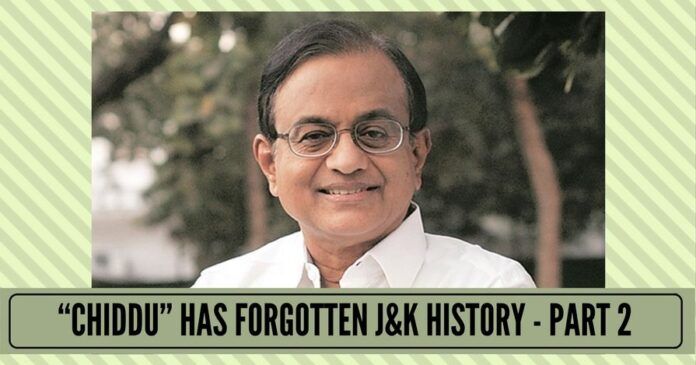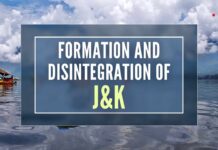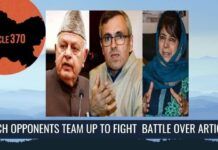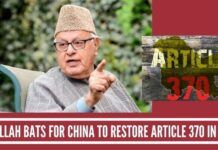
Part 1 of this article can be accessed here. This is part 2.
(This article is dedicated to the memory of Justice Adarsh Sein Anand who passed away in December last at age 81 leaving behind a landmark book titled The Constitution of Jammu & Kashmir — Its Development & Comments” which, first published in 1980, is now in its sixth edition. The extensive research which has gone into it was undertaken while the author was studying at London Law University, and before he entered the Bar Council. In the late nineties, this writer had the pleasure of being hosted with tea and ‘samosas’ in his home as the Chief Justice of India. He was as robust in assessing my own document on J&K posted in advance for his comment as he was in his book quoted extensively here. R.I.P.)
What began the unending bitter India-Pak issue is referred to by Justice Anand as the “Tribal Invasion.” Let it be described in his own well researched and authenticated words below.
On October 20, 1947, a large column of several thousand tribesmen armed with ‘bren guns, machine guns, mortars and flamethrowers’ attacked the frontiers of the State. ‘Srinagar trembled before the danger of the tribesmen’s invasion.” It was alleged that the tribesmen were being aided by Pakistan. Margaret Bourke White, who has done some research on the attack, records:
Certainly, these miniature ballistic establishments (the small factories in the tribal areas) would hardly explain the mortars, other heavy modern weapons and the two aeroplanes with which the invaders were equipped. In Pakistan towns close to the border arms were handed out before daylight to tribesmen directly from the front steps of Muslim League Headquarters. This was not quite the same thing as though the invaders were being armed directly by the Government of Pakistan. Still, Pakistan is a nation with one political party—the Muslim League.4
In his letter Maharaja Hari Singh lamented his plight and wrote out the stipulated Instrument of Accession which was unconditional, voluntary and absolute.
And V.P.Menon (an Indian civil servant who was the Constitutional Adviser and Political Reforms Commissioner to the last three Viceroys during British rule in India) observers that “to contend that the tribal invasion of Kashmir was wholly a spontaneous affair would be too huge a strain on human credulity”. The noted British Statesman, Lord Birdwood remarks “the fact that tribesmen carried a certain amount of equipment and arms which could not have come from the limited means of the tribal factories was a proof of a leakage from Pakistan’s regular forces”. But it is difficult to prove that the Government of Pakistan was at the back of the tribal invasion. However, it is an admitted fact that the tribesmen invaded Kashmir from Pakistan territory. And even if Pakistan was not directly aiding the tribesmen, its territory was being used by them for the purpose of the invasion.
The tribal invasion caused great devastation. By October 24th even the chronic indecision of Hari Singh (the then Maharaja of JK) deeply seated alarm and to a genuine concern for his personal safety. The raiders were now fast approaching Srinagar, the summer capital of Kashmir; the Maharaja was extremely nervous. The Dogra Army and the National Militia, which was a volunteer Muslim force formed by the National Conference, tried to hold the enemy’s onrush but prolonged resistance to well trained and well-equipped invaders was out of the question. The invaders were meanwhile pushing ahead, looting and destroying whatever came their way. The state was at this time in imminent peril and the Maharaja saw his dream of independence shattered like a house of cards. He thought of accession to save his State.
To save his life, Maharaja Hari Singh left his capital, Srinagar, and went to Jammu. He left his ‘beloved people to face the crisis. He appointed Sheikh Mohammed Abdullah, the general administration before leaving the summer capital. Sheikh Abdullah advised the Maharaja that if the State was to be saved, he must accede to India and ask for immediate military help.
Thus came his letter of 25th October 1947 to Lord Mountbatten, the Governor General of India. In that letter (available in “White Paper on Jammu and Kashmir, 1948” )he lamented his plight and wrote out the stipulated Instrument of Accession which was in no way different from that executed by some 500 other States. It was unconditional, voluntary and absolute.
About the legality of this accession, the following was what was written by Alan Campbell Johnson, OBE, who served as Press Attache to Lord Mountbatten as Viceroy of India.:
There was no forcible accession of JK to India. Whatever force came in October 1947 came from Pakistan only.
”The legality of the accession is beyond doubt…It should be stressed that the accession has complete validity both in terms of British Government’s and Jinnah’s expressed policy statements.”
And now comes this writer’s question which might well be asked by the supporters of “Chiddu’” claim stated in Part 1 of this two Part article, that
“The issue is the long-pending dispute concerning the accession of Kashmir. The state of J&K was forcibly divided following the first war between India and Pakistan in 1947,…”
In the J&K CON
Well, well, here’s the answer:
- Consequent to the Proclamation of the Yuvraj Karan Singh, of 1st May 1951, for a democratic and adult franchise among the entire population (women included), the elections to the Constituent Assembly of J&K were concluded by August of the same year and the first meeting of this Assembly was held on 31st October 1951. In his inaugural address, Sheikh Abdullah called that day as the “day of destiny”, “a day which comes only once in the life of a nation..” He called the Assembly a “Sovereign Authority” and, among the four main objects of the Assembly, he laid down the option “to decide its reasoned conclusions regarding the accession and the future of the State. He enumerated three alternatives: accession to India, accession to Pakistan or complete independence.” (Pg 1 of Opening Address in the J&K Constituent Assembly)
- On that first day, the subject of “accession” was sent to the Drafting Committee.
- On February 12, 1954, the Drafting Committee’s Report ratifying the accession was adopted three days later by the Constituent Assembly.
- On 7th November, 1956, the Assembly adopted and enacted the Jammu Kashmir State Constitution.
- Section 3 of the above State Constitution laid down that “The State of Jammu and Kashmir is and shall be an integral part of India.” Further, its Section 147 on Amendment of The Constitution laid down that the above Section was not amenable to and amendment.
- Section 4 of the above Constitution made it clear that the State’s Territory included the portions which were then not under the sovereignty of the State. Thus, the territory “Pakistan Occupied Territory” was declared as part of the Jammu&Kashmir State.
Conclusion: There was no forcible accession of JK to India. Whatever force came in October 1947 came from Pakistan only. The real and ONLY India-Pak dispute is the return by Pakistan to India of its forcibly occupied territory of the so-called “Azad Kashmir” as well as Gilgi-Baltistan. Q.E.D.
Note:
1. Text in Blue points to additional data on the topic.
2. The views expressed here are those of the author and do not necessarily represent or reflect the views of PGurus.
- To Editors’ Guild; May we also have our say… please? - July 17, 2019
- Farooq Sahab is either down with dementia or he is a congenital liar? - July 8, 2019
- Shah Bano, Muslims in gutter &Zakaria’s secularism - June 30, 2019










